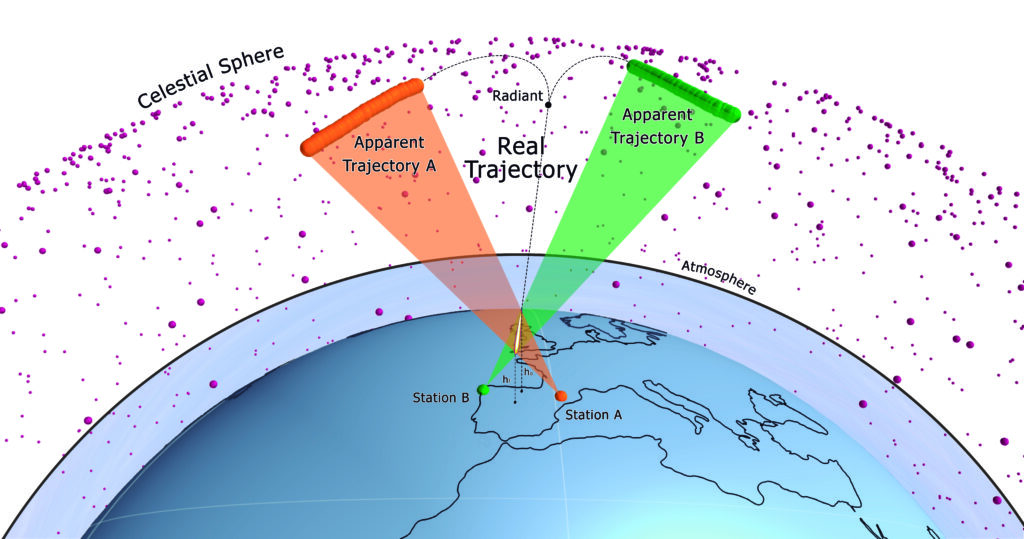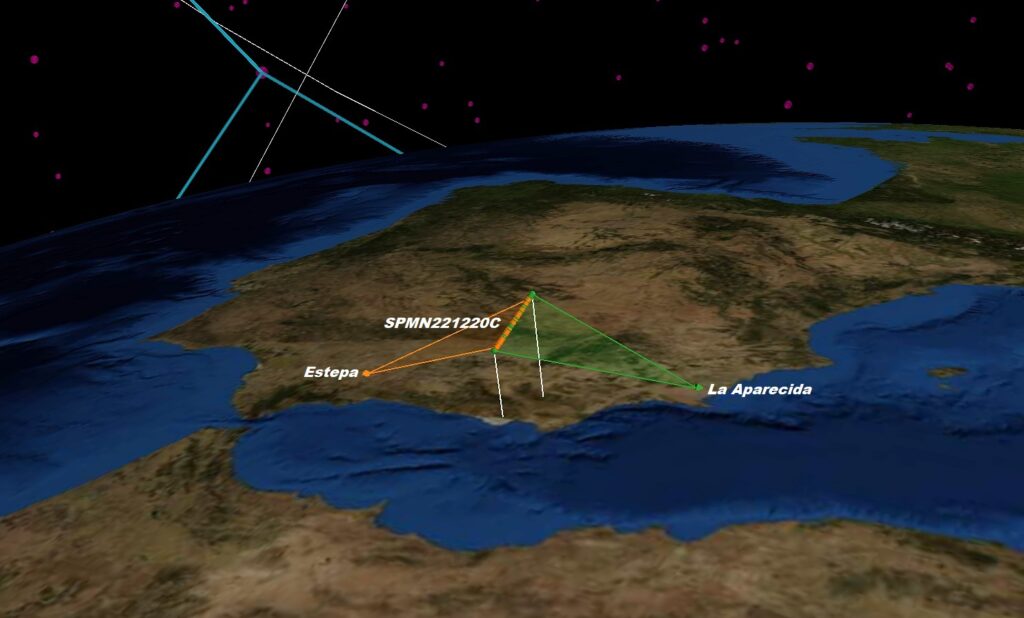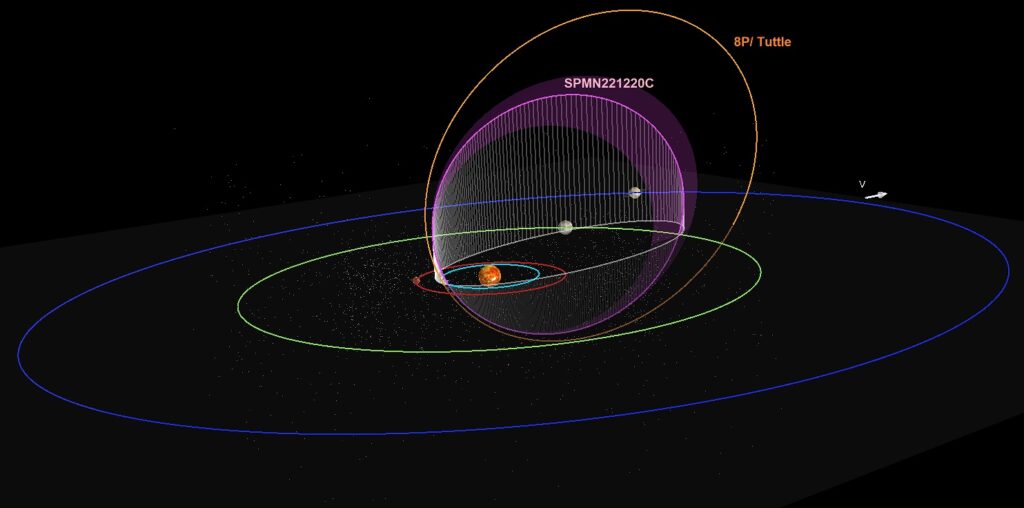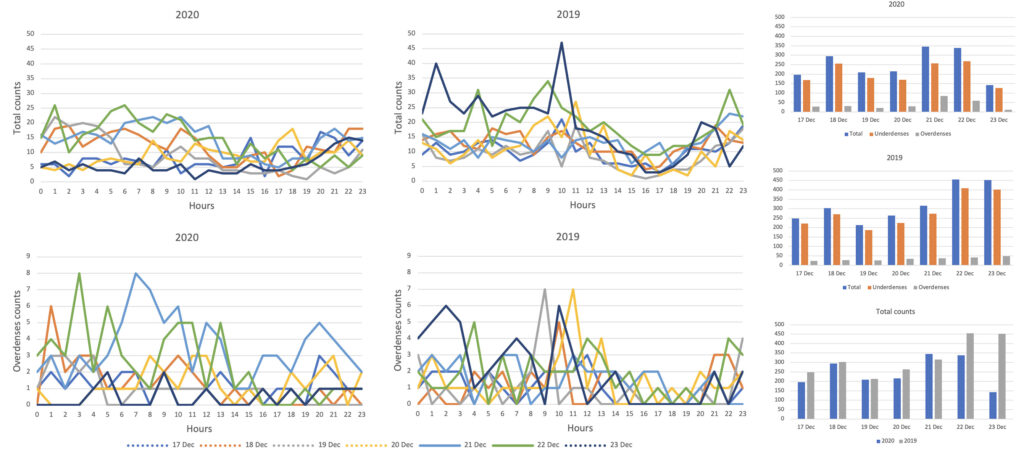By Eloy Peña Asensio, Josep M. Trigo Rodríguez, Albert Rimola, Jaime Izquierdo, Jaime Zamorano, Jordi Llorca, Joan Montanyà, Oscar van der Velde, Alberto Castro-Tirado, Manuel Moreno-Ibáñez, José A. Docobo, Pedro Pablo Campo, Manuel Andrade, Jacinto Alonso-Azcárate, Juan Fabregat, Estefania Blanch, David Altadill, Miguel Chioare Díaz, Ramón Iglesias Marzoa, Agustín Núñez, Víctor Lanchares, Alejandro Sánchez de Miguel, Francisco Ocaña González, José L. Ortiz, Vicente Cayuelas-Mollá, José A. de los Reyes, Sensi Pastor, Pep Pujols, Antonio Lasala, Diego Rodríguez, Amado Carbonell, Ángel Pérez Navarro, Antonio Fernández Sánchez, Antonio J. Robles, Armand Oliva, Carlos Alcaraz, César Guasch, Fernando Cabrerizo, Ferrán Ginebrosa Pérez, Josep M. Petit, Juan Carlos Tejedor, Julio Ribas, Lorenzo Morillas, Marc Corretgé Gilart, Miguel Aznar, Rubén Domènech Sanz, Vicent Ibáñez, Sergio López and Ramón López.
Abstract: We present a short update about the Spanish Fireball and Meteorite Recovery Network (in brief known as SPMN) after 25 years of continuous monitoring of the sky over Spain and bordering countries. A recent progress has been done in the development of a unique software called 3D-FireToc, which allows the detection and fully automatic reduction of photographic and video digital recordings. To exemplify the network coverage and the application of the code for a fireball analysis, we describe the 2020 Ursid meteor shower study and the event SPMN221220C.
1 The Spanish Meteor Network (SPMN)
The Spanish Meteor Network (SPMN) arose in 1996 in the framework of the first doctoral thesis focused on the study of the meteoric phenomenon, which was defended in 2002 (Trigo-Rodríguez, 2002). From the beginning, links were established between the professional and amateur astronomer community, establishing the foundations of the first active nodes (Trigo-Rodríguez et al., 2004; 2006a). Especially between 2003 and 2005 there was an intense period of collaboration between the nodes, with the fall on January 4, 2004 of the Villalbeto de la Peña chondrite in Palencia. The scientific results were the first recovery and characterization of a meteorite in 57 years (Llorca et al., 2005) and the ninth orbit of a meteorite in the world (Trigo-Rodríguez et al., 2006b).

Figure 1 – SPMN camera and forward-scatter stations.
At that time, the pioneering techniques applied by the members of the SPMN, and international collaborations led to the detection of large fireballs that allowed us to discover that near-Earth asteroids could also be meteorite producers (Trigo-Rodríguez et al., 2007). Just in that year (2007), the international congress Meteoroids 2007 was organized in Barcelona, where the members of the SPMN presented to the scientific community not only their first recovered meteorite (the chondrite L6 Villalbeto de la Peña) but also two other relevant achievements:
- the development of all-sky cameras and their application to the study of meteors and bolides (Trigo-Rodríguez et al., 2008), and
- the pioneering application of video-detection systems to the calculation of meteoroid orbits (Madiedo and Trigo-Rodríguez, 2008). In 2008, the fall of the second meteorite recovered in 2007 occurred: the eucrite Puerto Lápice. The study of this meteorite, from asteroid 4 Vesta, further encouraged scientific collaboration.
In the last decade, high impact results have been obtained, for example, forty refereed research articles, mostly in the first quartile and five published books. In addition, the various groups involved in the SPMN have been funded with research projects on a regular basis, expanding the detection systems and nodes. During this time, coordination of the enormous volume of data generated has been established through a mailing list sponsored by Red Iris and a database at ICE (CSIC/IEEC). In fact, three PhD theses directly related to SPMN research have been defended at this center since 2006, which, at the same time, have allowed the development of new techniques for the quantification of impact hazard by meteoroids and small asteroids (Moreno-Ibáñez et al., 2018; 2020).
The SPMN has currently 30 stations equipped with wide-angle video recorders and fisheye CCD cameras, as well as two forward-scatter systems (see Figure 1).
Now we are also organizing a very close cooperation with the French network FRIPON. Our astrometric method can be complementary and valuable to have the chance to increase the recovery of meteorites in Europe.
2 New 3D-FireTOC detection software
In recent years, new challenges have arisen associated with the exponential increase in the volume of data, the existence of heterogeneous systems and, finally, their astrometric reduction, which until recently was practically manual. This entailed a high number of manual tasks making the process slow and tedious. With the advance in the development of artificial vision and databases, the opportunity has opened up to automate the entire process: from the detection, recording and cataloguing of events to the precise extraction of the meteoroid trajectory. In this regard, in the framework of a final master thesis (Peña-Asensio, 2020), we started in 2019 the development of a Python-based software package called 3D-FireTOC (3D Fireball Trajectory and Orbit Calculator), a code capable of automating the detection and analysis of fireballs while producing a realistic 3D representation (Peña-Asensio et al., 2021a).

Figure 2 – Ilustration of the Method of Planes for computing the real trajectory and radiant position of the meteoroid.
The process begins by capturing a video of a meteoric event. For this purpose, we have implemented and extended the open-source CV2 OpenCV library (Bradski and Kaehler, 2000). The first step is to detect the movement of the fireball throughout the recording. This is achieved by evaluating the variation of the pixels with respect to a reference frame.
When entering the atmosphere at hypervelocity, meteoroids undergo an intense ablation process producing strong flares. These luminous bursts can saturate the pixels and reflect flares, making detection difficult and even generating false positives. Therefore, three methods have been developed to avoid these possible errors:
- a system of discrimination based on the area size detected,
- a real-time prediction of the next bolide position to narrow down the search area, and
- a post-processing to discard inconsistent points with a more or less straight and continuous trajectory.
The second step consists of performing astrometry of the recorded stars. The frames where the fireball does not appear are chosen in order to correctly measure the position and luminosity of the stars. The chosen frames are stacked and processed to reduce noise and highlight the reference stars. Using a stellar catalog, each of the identified stars is compared. Having the position in the image of each star and its position in the sky, it is possible by iterative methods to adjust a transformation matrix that converts pixels into real coordinates considering also the distortion produced by the lens. In this way, an apparent trajectory on the sky as seen from that location is obtained for each observation point.
Since these apparent trajectories are projections on the celestial sphere of the path travelled by the meteoroid in the atmosphere, it is necessary to combine two or more observations to triangulate the real position of the fireball. This is achieved using the plane intersection method developed by (Ceplecha, 1987), depicted in Figure 2. For each observation point, a mean plane containing the station and the apparent trajectory is generated, minimizing the error. As a result of the intersection of each of the generated planes, a straight line is obtained, through which the trajectory of the fireball must have passed. This is possible because the atmospheric flight of a meteoroid defines practically a perfect straight line due to its hypervelocity. One of the most complex parts of fireball analysis is to develop a mathematical model that adequately describes the flight in the atmosphere. One can describe this motion as a time-dependent third-order dynamical system, including air resistance and lift. This allows characterizing the atmospheric flight and estimating the initial and final mass, facilitating the classification of events according to their meteorite-producing capacity based on a method developed by (Gritsevich, 2009).
Finally, to calculate the orbital parameters of the heliocentric orbit of origin, it is first necessary to compute the radiant, that is, the position in the sky from which the fireball appears to come. This is achieved by propagating backward the atmospheric trajectory until it collides with the celestial sphere, or equivalently, by intersecting the great circles containing the apparent trajectories. It is also necessary to take into account the rotational motion of the Earth and the gravitational attraction on the meteoroid (Andreev, 1990). Once these considerations have been made, the orbit in the solar system of its parent body is obtained (Dubiago, 1961).
The automation of the bolide detection and analysis process facilitate dealing with the increasing massive data, which was beginning to saturate storage capacity. With the implementation of this new software, the SPMN gains in capacity to rapidly generate new knowledge about the hazards associated with large meteoroids and their dynamic association with comets, asteroids or even planetary bodies. In addition, this automation will allow the immediate preparation of fresh meteorite search campaigns.
3 Last study case: SPMN221220C
As a practical application of the 3D-FireTOC software, we report the very bright fireball SPMN221220C, which reached a magnitude of –9 ± 1. This event occurred on 2020 December 22nd (Peña-Asensio et al., 2021b) and was recorded by 3 SPMN stations, see Table 1 for the geographic coordinates and Figure 3 for the meteor trails.
The starting altitude was 111.8 ± 0.1 km and the observed velocity at its atmospheric inlet was 34.3 ± 0.1 km/s. The bolide suffered a disruption followed by a bright flare at 73.4 ± 0.1 km, having a velocity of 29.3 ± 0.1 km/s. A 3D representation of the atmospheric flight and the heliocentric orbit is depicted in Figure 4 in real scale.
Table 1 – Stations recording the event SPMN221220C.
| Station | Longitude | Latitude | Alt. |
| Estepa | 4°52’36” W | 37°17’29” N | 537 m |
| La Aparecida | 1°00’14” W | 38°04’54” N | 35 m |
| La Murta | 1°40’32” W | 38°05’48” N | 469 m |

Figure 3 – SPMN221220C recorded from Estepa, Sevilla (left) and from La Aparecida, Alacant (center) and La Murta, Murcia (right).


Figure 4 – Top: SPMN221220C atmospheric reconstruction with Estepa (orange) and La Aparecida (green) stations. Bottom: The computed heliocentric orbit of SPMN221220C and 8P/Tuttle.
The aerodynamic strength results in 4.35 ± 0.10 kPa. Both the velocity, radiant and calculated orbital parameters point out to a clear association with the Ursids, and the parent comet 8P/Tuttle (Figure 4), as compared with the annual component given by (Jenniskens, 2006). The radiant, velocities and orbital parameters for PMN221220C:
- αo= 213.8 ± 0.8°
- δo= 74.2 ± 0.3°
- v∞= 34.29 ± 0.12 km/s
- αg= 219.6 ± 1.3°
- δg= 74.5 ± 0.6°
- vg= 65.6 ± 0.6 km/s
- αh= 18.0 ± 0.6°
- δh= 51.2 ± 0.5°
- vh= 39.6 ± 0.3 km/s
- a= 3.8 ± 0.4 AU
- e= 0.749 ± 0.027
- q= 0.9424 ± 0.0028 AU
- ω= 205.6 ± 0.9°
- Ω= 270.425 ± 0.006°
- i = 52.5 ± 0.5°
Figure 5 shows the velocity curve superimposed with the photometric counts from the 3 stations. As expected, an abrupt drop in velocity is observed at the moment of maximum luminosity, i.e., when the blast that causes the catastrophic disruption of the meteoroid occurs.

Figure 5 – SPMN221220C observed velocity curve crossed with the normalized photometric counts.
In addition, we also recorded the meteor activity from Fuenlabrada and Jaén forward-scatter stations. Figure 6 shows the data compared with 2019 Ursids activity from the same stations. The 2020 Ursids did not produce an outburst as predicted by Jenniskens (2006), but still provided a nice display. From the data collected (Figure 6), an average flux of 20 echoes per hour was estimated, exhibiting a particular peak on the 21st and 22nd of overdenses echoes. The 2020 Ursid activity was even smaller than that of 2019, without any evidence of outburst.

Figure 6 – Forward-scatter comparison of 2020 and 2019 Ursids activity by days and hours.
4 Conclusion
After the long road travelled together, both professionals and amateurs involved in the Spanish Meteor Network (SPMN), we have the challenge to continue collaborating to promote the study of interplanetary matter and meteoritics. Among our future objectives, we can identify the following ones:
- Automated bolide trajectory and orbit reconstruction, controlling the maintenance of a database of meteoroid orbits that will allow automated searches with their parent bodies.
- As the main scientific objective of our network, to use that database to identify possible meteorite falls. To join efforts in the recovery and characterization of meteorites.
- To deepen in those techniques that allow us to understand in-depth the nature and magnitude of the danger of impact by small asteroids.
As an example of all the work developed and the latest advances implemented in the SPMN detection network, we analyzed the SPMN221220C event and the 2020 Ursids activity. The 2020 Ursids have not produced a meteor outburst but were composed of large meteoroids producing a nice fireball display. The maximum occurred at solar longitude 270.315º (J2000.0) with a meteoroid flux estimated from three video stations in the visual range up to magnitude +4 was 20 meteoroids/1000 km^2·h.
Acknowledgment
We thank the coordination task in the framework of research project PGC2018-097374-B-I00 (PI: JMT-R), funded by FEDER/MCI-AEI. We also recognize the dedication of the different professional and amateur observing nodes contributing to the network. EPA acknowledges financial support from the European Research Council (ERC) under the European Union’s Horizon 2020 research and innovation program (grant agreement No. 865657) for the project “Quantum Chemistry on Interstellar Grains” (QUANTUMGRAIN).
References
Andreev G. (1991). “The influence of the meteor position on the zenith attraction”. In, Heinlein, D.; Koschny, D., editors, Proceedings of the International Meteor Conference, Violau, Germany, 6-9 September 1990. IMO, pages 25–27.
Bradski G. and Kaehler A. (2000). OpenCV. Dr. Dobb’s Journal of Software Tools 3.
Ceplecha Z. (1987). “Geometric, dynamic, orbital and photometric data on meteoroids from photographic fireball networks”. Bulletin of the Astronomical Institutes of Czechoslovakia, 38, 222–234.
Dubiago A. D. (1961). The determination of orbits. New York.
Gritsevich M. I. (2009). “Determination of parameters of meteor bodies based on flight observational data”. Advances in Space Research, 44, 323–334.
Jenniskens P. (2006). Meteor showers and their parent comets. Cambridge University Press.
Llorca J., Trigo-Rodríguez J. M., Ortiz J. L., Docobo J. A., García-Guinea J., Castro-Tirado A. J., Rubin A. E., Eugster O., Edwards W., Laubenstein M., Casanova I. (2005). “The Villalbeto de la Peña meteorite fall: I. Fireball energy, meteorite recovery, strewn field, and petrography”. Meteoritics & Planetary Science, 40, 795–804.
Llorca J., Casanova I., Trigo-Rodríguez J. M., Madiedo J. M., Roszjar J., Bischoff A., Ott U., Franchi I., Greenwood R.C. and Laubenstein M. (2019). “The Puerto Lápice eucrite.” Meteoritics & Planetary Science, 44, 159–174.
Madiedo J.M. and Trigo-Rodríguez J.M. (2008). “Multi-station video orbits of minor meteor showers”. Earth Moon and Planets, 102, 133–139.
Moreno-Ibáñez M., Silber E. A., Gritsevich M., Trigo-Rodríguez J. M. (2018). “Verification of the Flow Regimes Based on High-fidelity Observations of Bright Meteors”. Astrophysical Journal, 863, art. id.174, 41 pp.
Moreno-Ibáñez M., Gritsevich M., Trigo-Rodríguez J. M., Silber E. A. (2020). “Physically based alternative to the PE criterion for meteoroids”. Monthly Notices of the Royal Astronomical Society, 494, 316–324.
Peña Asensio E. (2020). “Impact hazard assessment from the automatic detection of meteoric and re-entry fireballs recorded by the SPMN network”. Master’s thesis, Universitat Politècnica de Catalunya. Directed by Josep M. Trigo-Rodríguez at ICE (IEEC-CSIC).
Peña-Asensio E., Trigo-Rodríguez J. M., Gritsevich M., Rimola A. (2021a). “Accurate 3D fireball trajectory and orbit calculation using the 3D-FireTOC automatic Python code”. Monthly Notices of the Royal Astronomical Society, https://doi.org/10.1093/mnras/stab999.
Peña-Asensio E., Trigo-Rodríguez J. M., Rimola A., Izquierdo J., Chioare M., Morillas L. G., Pérez A., Reyes J. A., Pastor S., Cayuelas-Mollá V., Robles A. J., Lasala A., Pujols P., Tejedor J. C., Aznar M., Orduña L., Ribas J., Rodríguez D., Carbonell A., Domènech R., Ibáñez V., Guasch C., Fernández A., Alcaraz C., Oliva A. (2021b). “2020 Ursid Meteor Shower Activity from Video Recordings and Forward-Scatter Echo Detections”. 52nd Lunar and Planetary Science Conference, held virtually, 15-19 March, 2021. LPI Contribution No. 2548, id.1174.
Trigo-Rodriguez J. M. (2002). Análisis espectroscópico de fragmentos cometarios y asteroidales a su entrada en la atmósfera terrestre. PhD thesis, Universitat de Valencia.
Trigo-Rodríguez J. M., Castro-Tirado A. J., Llorca J., Fabregat J., Martínez V. J., Reglero V., Jelínek M., Kubánek P., Mateo T., de Ugarte Postigo A. (2004). “The development of the Spanish Fireball Network using a new all-sky CCD system”. Earth, Moon & Planets, 95, 375–387.
Trigo-Rodríguez J. M., Llorca J., Castro-Tirado A. J., Ortiz J. L., Docobo J. A. and Fabrega J. (2006a). “The Spanish fireball network”. Astronomy & Geophysics, 47, pp. 6.26–6.28.
Trigo-Rodríguez J. M., Borovička J., Spurný P., Ortiz J. L., Docobo J. A., Castro-Tirado A. J. (2006b). “The Villalbeto de la Peña meteorite fall: II. Determination of atmospheric trajectory and orbit”. Meteoritics & Planetary Science, 41, 505–517.
Trigo-Rodríguez J. M., Lyytinen E., Jones D. C., Madiedo J. M., Castro-Tirado J. M., Williams I., Llorca J., Vítek S., Jelínek M., Troughton B., Gálvez F. (2007). “Asteroid 2002NY40 as source of meteorite-dropping bolides”. Monthly Notices of the Royal Astronomical Society, 382, 1933–1939.
Trigo-Rodriguez J M., Madiedo J. M., Gural P. S., Castro-Tirado A. J., Llorca J., Fabregat J., Vítek S. and Pujols P. (2008). “Determination of meteoroid orbits and spatial fluxes by using high-resolution all-sky CCD cameras”. Earth Moon and Planets, 102,
231–240.

